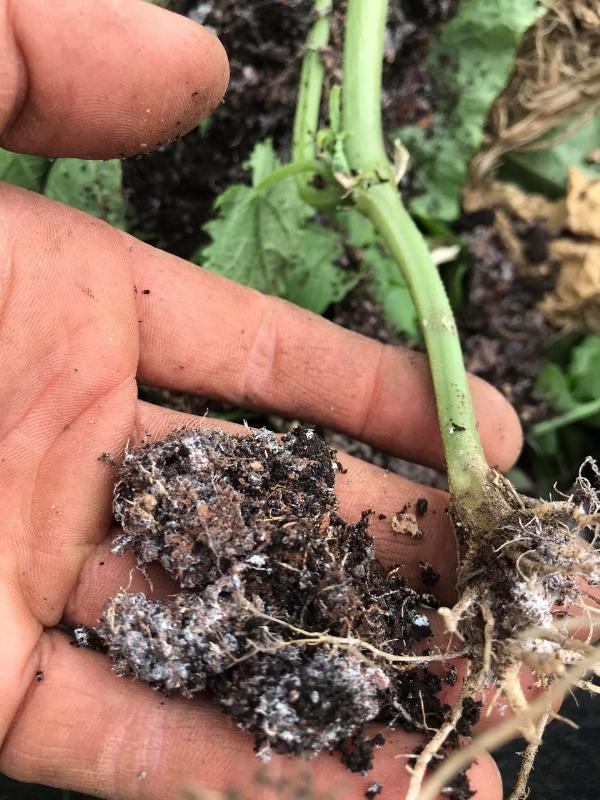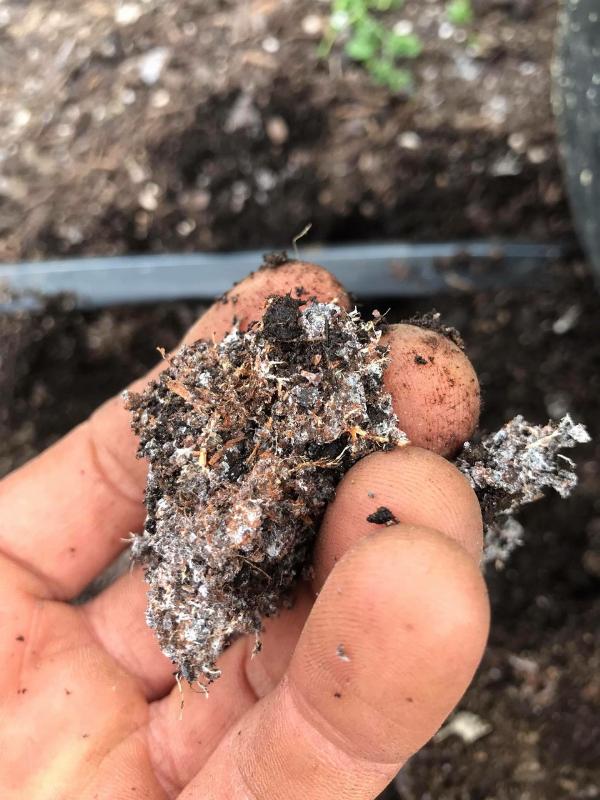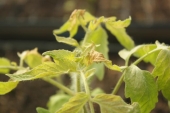
 1
1







 1
1




Invasive plants are Earth's way of insisting we notice her medicines. Stephen Herrod Buhner
Everyone learns what works by learning what doesn't work. Stephen Herrod Buhner
 3
3
















Ah, I never realised that mychorizal fungi fruited! Maybe it's just Arbuscular mycorrhiza that don't? Or I may just be completely off-base?Kevin Hoover wrote:It may be, but I’d like to make several points.
You do indeed get fruiting bodies from mychorizal fungus. Many of the wild mushrooms we collect (Chanterelles, Parasols, etc.) are, as well as many we will not collect (Russulas, Aminitas). As I type this, I’m cooking some Hydnum umbilicatum that I picked this morning, which was mychorizal with hemlock trees.
The fact that the plant you showed was healthier points to mychorizal to me.
The fact that he saw the mycelium away from the plant was not surprising. Mycelium spreads over a large area. The other possibility is that you have multiple species of mycelium, and it’s possible to have both types.
Even if it is saprotrophic, it’s probably beneficial to the plants as it’s breaking down something in the soil so that your vegetables can intake it more easily.
If it was hurting the live plant it would be considered parasitic.




Visit Redhawk's soil series: https://permies.com/wiki/redhawk-soil
How permies.com works: https://permies.com/wiki/34193/permies-works-links-threads
 1
1








Dear no! I meant that Nature meant to do no harm by the white stuff it grew in your garden, just like the slime mold meant no harm to my tomatoes. I agree that the more we understand things, the more we can keep trying to work symbiotically with nature.Jon Crossen wrote:Anyway, we weren't planning to "treat" anything (if thats what you meant by "do no harm") - just keen to get a greater understanding of the biology happening under foot!
As in totally stable, or just "more stable"? I'm not sure that "totally stable" is even my goal? Living on the North Wet Coast, I see the fluctuations caused by El Nino which affects our weather and I see how the balance of predator and prey shift as my area has discouraged artificial pesticides, and if you look long enough through Earth's geological history, stable on a grand scale simply isn't a realistic target!But it's an unachievable aspiration.
Visit Redhawk's soil series: https://permies.com/wiki/redhawk-soil
How permies.com works: https://permies.com/wiki/34193/permies-works-links-threads




Oh absolutely! Nature doesn't make "mistakes," I don't believe a plant has ever grown in the wrong place or that a disease is ever a "problem" in nature - only when we apply human needs and obsession to dominate.Jay Angler wrote:
Dear no! I meant that Nature meant to do no harm by the white stuff it grew in your garden, just like the slime mold meant no harm to my tomatoes. I agree that the more we understand things, the more we can keep trying to work symbiotically with nature.Jon Crossen wrote:Anyway, we weren't planning to "treat" anything (if thats what you meant by "do no harm") - just keen to get a greater understanding of the biology happening under foot!
Yeah, stability is the wrong term.As in totally stable, or just "more stable"? I'm not sure that "totally stable" is even my goal? Living on the North Wet Coast, I see the fluctuations caused by El Nino which affects our weather and I see how the balance of predator and prey shift as my area has discouraged artificial pesticides, and if you look long enough through Earth's geological history, stable on a grand scale simply isn't a realistic target!
I'd be happy if more people just opened their eyes to how Nature works *with* us and how we need to ditch the old attitude of "conquering" or "subduing" or "ruling over" Nature and do more that supports the very picture you posted.




Let's not get me started on that subject or we'll both get booted over to the Cider Press.I agree with ye in a philosophical sense. It's been a fascinating journey going from a few years living essentially money-less living in permaculture-esque communities and wwoofing, to trying to apply what I've learnt in mainstream society with it's economic pressures.
If you’re planning on running a permaculture farm, Paul recommends following Richard Perkins
Visit Redhawk's soil series: https://permies.com/wiki/redhawk-soil
How permies.com works: https://permies.com/wiki/34193/permies-works-links-threads
 1
1




Yeah, I have that book on order. I'm intriuged to read it - I've heard fairly... "mixed" things about Richard Perkins.Jay Angler wrote:Jon Crossen wrote:
Let's not get me started on that subject or we'll both get booted over to the Cider Press.I agree with ye in a philosophical sense. It's been a fascinating journey going from a few years living essentially money-less living in permaculture-esque communities and wwoofing, to trying to apply what I've learnt in mainstream society with it's economic pressures.
That said, I was just reading something related to one of Paul's podcasts:
https://permies.com/wiki/169302/Podcast-Gardening-Farming
If you’re planning on running a permaculture farm, Paul recommends following Richard Perkins
I've watched one of Richard's videos and it made sense to me for "farming", but on the veggie side, I'm really just "gardening" so I didn't explore it further. The pressure on farmers and their land in many countries is huge, but personally, we *have* to find better ways that protect the soil while still providing farmers and farm workers a living wage or we're going to be living the Science Fiction futures where all the food is vat grown. I'm afraid I'm just not convinced that will really be as healthy and complete as eating real food grown in real soil with the help of real micro-organisms.
For example there's excitement these days about "vat grown meat - no animal needs to die". But meat is supposed to be muscle tissue, and I know enough about biology and muscles that what makes muscles useful is exercise! What makes muscle "tender" is having a poor calf chained in a box so it can't exercise, but that means it's missing out on all the micronutrients it would get from actually eating grass and forbs, so that makes me question whether vat grown would ever be as good as me raising a Muscovy duck out on my field until harvest day. Any bit of that duck I can't use, gets composted to raise my plants. But I can't make any money raising Muscovy ducks, because our laws and systems are set up for industrial farming.




Have you had a look at that PEP program? https://permies.com/wiki/skip-pep-bbI do know of a few older land owners who are being more considerate about making sure their resource ends up with someone who wants to do the right thing
Visit Redhawk's soil series: https://permies.com/wiki/redhawk-soil
How permies.com works: https://permies.com/wiki/34193/permies-works-links-threads
 1
1




Jon Crossen wrote:
However, I still understood that you don't really see hyphae on myco fungi? Again, happy to be corrected!
I agree I don't think it's parasitic!
“The most important decision we make is whether we believe we live in a friendly or hostile universe.”― Albert Einstein
 1
1




I am the mulch queen!

 1
1




I know I've read, (but can't remember where) of some some fungi that are *known* to be parasitic, are in fact only parasitic in *some* circumstances. Apparently under some conditions, they may actually be fulfilling a symbiotic role.





|
If you open the box, you will find Heisenberg strangling Shrodenger's cat. And waving this tiny ad:
The new gardening playing cards kickstarter is now live!
https://www.kickstarter.com/projects/paulwheaton/garden-cards
|








